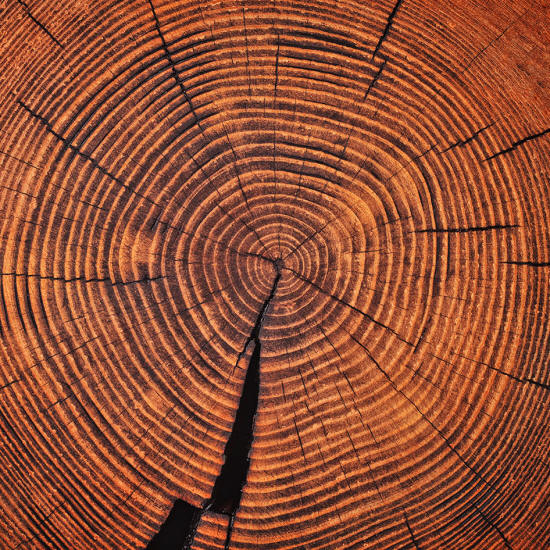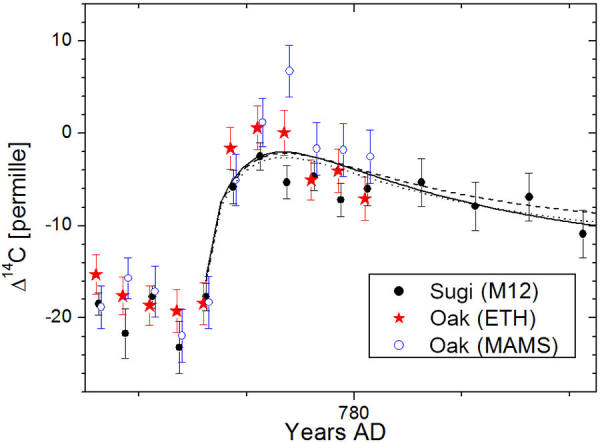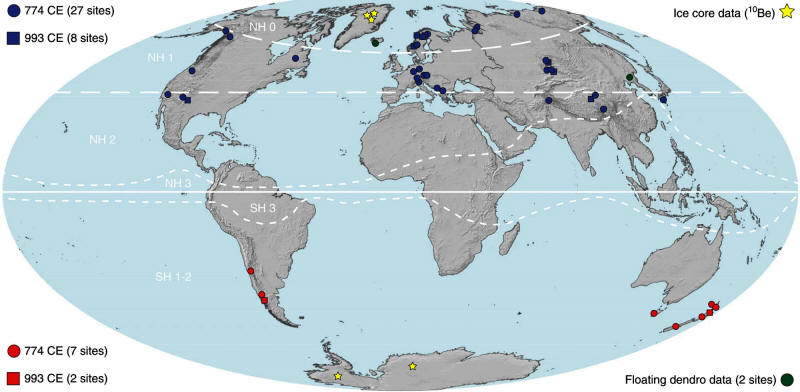|

31 January 2025
from
Spaceweather Website

How
bad can a solar storm be?
Just ask a
tree.
Unlike
human records,
which go
back hundreds of years,
trees can
remember solar storms
for
millennia...
Nagoya University doctoral student Fusa Miyake made the
discovery in 2012 while studying rings in the stump of a
1900-year-old Japanese cedar.
One ring, in particular, drew her attention.
Grown in the year 774-75 AD, it contained a
12% jump in radioactive carbon-14 (14C), about 20 times greater
than ordinary fluctuations from cosmic radiation.
Other teams confirmed the spike in wood from
Germany, Russia, the United States, Finland, and New Zealand.
Whatever happened, trees all over the
world experienced it.
Most researchers think it was a solar storm -
an extraordinary one...
Often, we point to the
Carrington Event of 1859 as the
worst-case scenario for solar storms.
The 774-75 AD storm was at least 10 times
stronger:
if it happened today, it would floor modern
technology...
Since Miyake's initial discovery, she and others
have confirmed five more examples (12,450 BC, 7176 BC, 5259 BC,
664-663 BC, 993 AD).
Researchers call them "Miyake
Events."

The 774-775 AD
carbon-14
spike.
[more]
It's not clear that all Miyake Events are caused by the sun.
Supernova explosions and gamma-ray bursts
also produce carbon-14 spikes.
However, the evidence tilts toward solar storms.
For each of the confirmed Miyake Events,
researchers have found matching spikes of 10Be and 36Cl in ice
cores. These isotopes are known to trace strong solar activity.
Moreover, the 774-75 AD Miyake Event had
eyewitnesses;
historical reports of auroras
suggest the sun was extremely active around that time.
Miyake Events have placed dendrochronologists (scientists who
study tree rings) in the center of space weather research.
After Miyake's initial discovery in 2012, the
international tree ring community began working together to look for
evidence of solar superstorms.
Their collaboration is called "the COSMIC
initiative."
First results published in a 2018
edition of Nature confirm that,
Miyake Events in 774-75 AD and 993 AD were
indeed global.
Trees on five continents recorded carbon
spikes.

A global map of
COSMIC tree
ring and ice core measurements
[more]
"There could be additional Miyake Events
throughout the
Holocene" says Irina
Panyushkina, a member of the COSMIC initiative from the
University of Arizona's Laboratory for Tree-Ring Research.
"An important new source of data are
floating tree-ring records from
Eurasia and the Great Lakes region. These are very old rings
that could potentially capture 14C spikes as far back as 15,000
years.
Eventually, I believe we will have a complete
record of Miyake Events throughout that period."
Four more candidates for Miyake Events
have recently been identified:
5628 BC, 5410 BC, 1052 DC, and 1279 DC...
Confirmation requires checking trees on many
continents and finding matching spikes of 10Be and 36Cl in ice
cores.
It's all part of the "slow and systematic
process" of radiocarbon tree ring research, says Dr. Panyushkina.
A complete survey of Miyake Events could
tell us how often solar superstorms occur and how much peril the sun
presents to a technological society.
|




